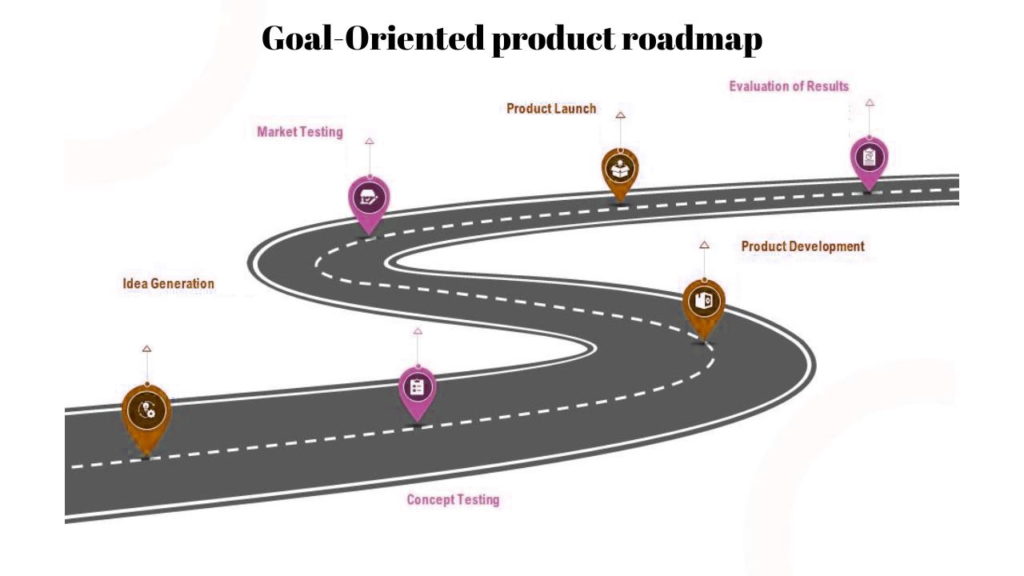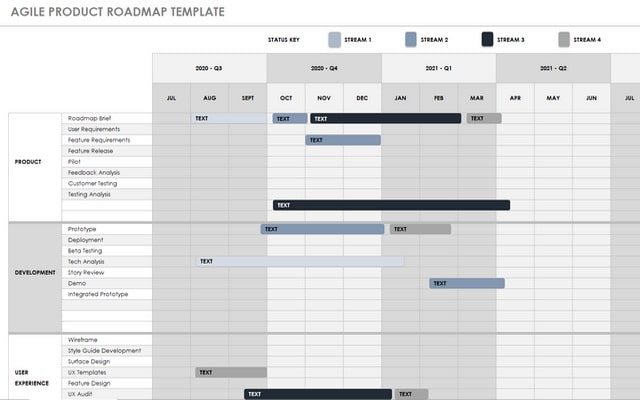Free 10-Step Guide to Product Roadmaps
Summary
Welcome to our comprehensive guide to product roadmaps in an Agile environment.
In this guide, we will explore what a product roadmap is, why it is important, who is responsible for creating and maintaining it, and how to effectively plan, prioritize, and present your roadmap.
We will also provide you with valuable tips and best practices to help you create powerful roadmaps that align with your product strategy.
Finally, we will conclude with a free product roadmap template for you to download and use.
What is a product roadmap?
A product roadmap is a visual representation of the strategic direction and future plans for a product. It outlines the high-level goals, features, and timeline for product development. The roadmap provides a shared understanding of where the product is headed and is a communication tool for stakeholders. You might also want to read about the Technology roadmap on Wikipedia.
Example:
Let’s say you’re working on a software development project for a new mobile application.
A product roadmap for this project would be a visual representation that showcases the app’s strategic direction and future plans. It would outline the high-level goals, features, and timeline for the development process.
For example, one of the goals might be to enhance the user experience by introducing a more intuitive interface. The roadmap would then highlight the specific features and their corresponding timeline, such as implementing a new navigation system and revamping the overall design.
This visual roadmap would provide all stakeholders, including the development team, management, and investors, with a clear understanding of the app’s trajectory and the steps required to achieve the desired outcomes. It serves as a powerful communication tool that aligns everyone involved and ensures that everyone is working towards the same strategic vision.
Why is a product roadmap important?
A product roadmap is crucial for several reasons. It helps align the product team, stakeholders, and customers on the product vision and strategy.
It provides clarity and transparency about the product’s direction and priorities.
Additionally, the roadmap facilitates collaboration, decision-making, and resource allocation. It also allows for early feedback and enables the team to adapt and respond to changes in the market and customer needs.
Who is responsible for the product roadmap?
The product roadmap is a collaborative effort involving various stakeholders, but ultimately, the product owner is responsible for creating and maintaining it. They work closely with the developers, business stakeholders, and customers to gather input, define goals, and prioritize features.
The product manager should ensure that the roadmap aligns with the overall product strategy and is regularly updated based on feedback and market insights.
Who uses product roadmaps?
Different groups of stakeholders use product roadmaps for different purposes.
Internally, the developers rely on the roadmap to understand the product vision and prioritize their work.
Business stakeholders use it to align the product strategy with company goals and make informed decisions about resource allocation.
Sales and marketing teams utilize the roadmap to plan and align their activities.
Externally, customers and users benefit from the roadmap by gaining visibility into the future direction of the product.
How do you plan what goes on a product roadmap?
Planning a product roadmap involves a systematic approach.
Start by defining your product strategy (CLICK HERE TO READ HOW YOU CAN BUILD A POWERFULL PRODUCT STRATEGY IN 7 STEPS), understand customer needs, and conduct market research.
Identify the high-level goals and initiatives that will help achieve your strategy.
Break down these initiatives into features and prioritize them based on value, feasibility, and dependencies.
Consider input from stakeholders and ensure a balanced representation of short-term and long-term goals.
Continuously review and refine the roadmap as new information becomes available.

How to create a Goal-Oriented product roadmap?
To create a goal-oriented product roadmap, it is essential to align your roadmap with your product strategy and goals.
Clearly define your product vision and overarching objectives. Break down these objectives into measurable goals that can be tracked and evaluated.
Align the features on your roadmap with these goals, ensuring that each feature contributes directly to achieving them. By maintaining this goal-oriented approach, you ensure that your roadmap remains focused and aligned with your strategic objectives.
Here’s a step-by-step guide on how to create a goal-oriented product roadmap:
- Align with product strategy and goals: Start by aligning your roadmap with your product strategy and goals. Understand the vision for your product and identify the overarching objectives that support that vision.
- Define measurable goals: Break down your objectives into specific, measurable goals. These goals should be clear and actionable, allowing you to track progress and evaluate success. For example, if your objective is to increase user engagement, a goal could be to improve the onboarding process to increase user retention by 20%.
- Identify features that support the goals: Evaluate the features or initiatives that can contribute to achieving each goal. Consider how each feature aligns with the objectives and whether it directly supports the desired outcome. Eliminate features that do not contribute to the goals or are not aligned with the product strategy.
- Prioritize goal-aligned features: Prioritize the features based on their alignment with the goals and their potential impact. Consider the value each feature brings to the user and the business, as well as the effort and resources required for implementation. Ensure that the features with the highest impact on the goals are given priority.
- Visualize the roadmap: Create a visual representation of your goal-oriented roadmap. This can be in the form of a timeline or a strategic chart. Clearly indicate the goals and the features associated with each goal. Use colors or labels to differentiate between short-term and long-term goals.
- Review and refine: Continuously review and refine your roadmap as you gather feedback and insights. Regularly reassess the goals and the alignment of features. Adapt the roadmap based on new information and changing priorities to ensure it remains focused and aligned with your strategic objectives.
By following these steps, you can create a goal-oriented product roadmap that ensures your efforts are focused on achieving your product strategy and goals.
Remember to regularly review and update your roadmap as your product evolves and new information becomes available.
How do you prioritize features for the product roadmap?
Prioritizing features for the product roadmap involves considering multiple factors.
Start by evaluating the value of each feature to the user and the business. Assess the effort and resources required for implementation.
Consider dependencies and the potential impact on the overall product vision. Engage stakeholders to gather their perspectives and insights. Leverage techniques like MoSCoW (Must-haves, Should-haves, Could-haves, and Won’t-haves) or the RICE prioritization framework (Reach, Impact, Confidence, and Effort) to aid in decision-making.
Continuously reevaluate and reprioritize as new information emerges.
Presenting the product roadmap
When presenting the product roadmap, it’s crucial to consider your audience and their specific needs:
- Tailor the level of detail to ensure clarity and avoid overwhelming stakeholders.
- Use visual aids, such as charts or timelines, to enhance understanding.
- Provide context by explaining the rationale behind the roadmap and the prioritization decisions.
- Encourage questions and discussions to foster engagement and alignment.
- Regularly update and communicate changes to keep stakeholders informed and maintain transparency.
Using and updating the roadmap
A product roadmap is a living document that evolves over time. Continuously refer to the roadmap during development to ensure alignment and guide decision-making.
Regularly update the roadmap based on feedback, market changes, and new insights.
Engage with stakeholders and the development team to gather input and validate assumptions.
Consider using Agile methodologies, such as Scrum Framework, to iteratively update and refine the roadmap as the product progresses. Regularly communicate updates to stakeholders to maintain transparency and alignment.
Tips and Best Practices for the Product Roadmaps
To create effective and impactful roadmaps, consider the following tips and best practices:
- Clearly articulate your product vision and strategy. (All this and more you can find for free on our blog)
- Involve stakeholders and customers in the roadmap creation process.
- Focus on goals and outcomes rather than specific features.
- Prioritize ruthlessly based on value and feasibility.
- Use data and evidence to support your prioritization decisions.
- Ensure the roadmap is easily understandable and visually appealing.
- Regularly communicate updates and changes to stakeholders.
- Continuously refine and adapt the roadmap based on feedback and insights.
Conclusion and download Free Product Roadmap Template
In conclusion, a product roadmap is a powerful tool for aligning teams, stakeholders, and customers on the strategic direction of a product.
By following the guidelines in this guide, you can create a goal-oriented and effective product roadmap in an Agile environment. Remember to involve stakeholders, prioritize features based on value, and regularly update and communicate changes.
To get started, download our free product roadmap template, which will be valuable in your product planning and communication efforts. Send us an email to agileandscrummasterclass |@| gmail.com and I will send it right away.
Happy road mapping!
Product roadmaps should be updated regularly, typically every quarter or whenever there are significant changes in priorities, market conditions, or customer feedback.
The creation of a product roadmap should involve input from key stakeholders, including product managers, product owners, development teams, business stakeholders, and customer representatives.
When faced with changes or unexpected events, it is important to reassess the impact on the roadmap, prioritize accordingly, and communicate updates to stakeholders transparently to ensure alignment and manage expectations.
Yes, a product roadmap can and should include both short-term and long-term goals to provide a holistic view of the product’s direction, with short-term goals addressing immediate needs and long-term goals aligning with the overall product strategy.
Balancing flexibility with sticking to the roadmap involves regularly reviewing and adapting the roadmap based on new information, feedback, and market conditions, while ensuring that any changes are aligned with the product strategy and overall goals.
